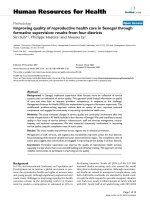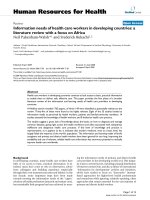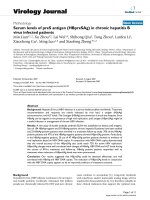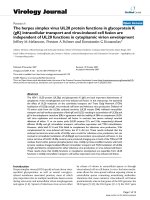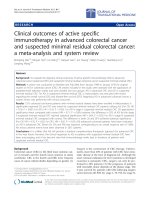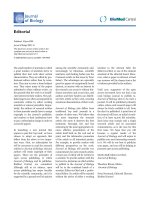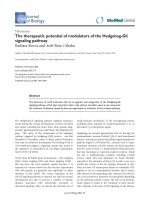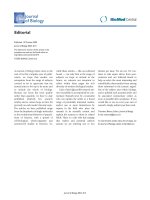Báo cáo sinh học: "The consequences of including non-additive effects on the genetic evaluation of harvest body weight in Coho salmon (Oncorhynchus kisutch)" ppt
Bạn đang xem bản rút gọn của tài liệu. Xem và tải ngay bản đầy đủ của tài liệu tại đây (647.92 KB, 8 trang )
Genetics
Selection
Evolution
Gallardo et al. Genetics Selection Evolution 2010, 42:19
/>Open Access
RESEARCH
© 2010 Gallardo et al; licensee BioMed Central Ltd. This is an Open Access article distributed under the terms of the Creative Commons
Attribution License ( which permits unrestricted use, distribution, and reproduction in
any medium, provided the original work is properly cited.
Research
The consequences of including non-additive
effects on the genetic evaluation of harvest body
weight in Coho salmon (
Oncorhynchus kisutch
)
José A Gallardo
1
, Jean P Lhorente
2
and Roberto Neira*
2,3
Abstract
Background: In this study, we used different animal models to estimate genetic and environmental variance
components on harvest weight in two populations of Oncorhynchus kisutch, forming two classes i.e. odd- and even-
year spawners.
Methods: The models used were: additive, with and without inbreeding as a covariable (A + F and A respectively);
additive plus common environmental due to full-sib families and inbreeding (A + C + F); additive plus parental
dominance and inbreeding (A + D + F); and a full model (A + C + D + F). Genetic parameters and breeding values
obtained by different models were compared to evaluate the consequences of including non-additive effects on
genetic evaluation.
Results: Including inbreeding as a covariable did not affect the estimation of genetic parameters, but heritability was
reduced when dominance or common environmental effects were included. A high heritability for harvest weight was
estimated in both populations (even = 0.46 and odd = 0.50) when simple additive models (A + F and A) were used.
Heritabilities decreased to 0.21 (even) and 0.37 (odd) when the full model was used (A + C + D + F). In this full model,
the magnitude of the dominance variance was 0.19 (even) and 0.06 (odd), while the magnitude of the common
environmental effect was lower than 0.01 in both populations. The correlation between breeding values estimated
with different models was very high in all cases (i.e. higher than 0.98). However, ranking of the 30 best males and the
100 best females per generation changed when a high dominance variance was estimated, as was the case in one of
the two populations (even).
Conclusions: Dominance and common environmental variance may be important components of variance in harvest
weight in O. kisutch, thus not including them may produce an overestimation of the predicted response; furthermore,
genetic evaluation was seen to be partially affected, since the ranking of selected animals changed with the inclusion
of non-additive effects in the animal model.
Background
Several studies have shown that non-additive effects like
common environmental and dominance genetic effects
can be an important component in the total phenotypic
variance of quantitative traits in fish [1-6]. In salmon
breeding, common environmental effects may be
observed when members of different families are reared
in separate tanks until the fish reach a sufficiently large
size for individual physical marking. Common environ-
mental variance represents a proportion of the total phe-
notype variance and ranges from 0 to 0.09 for growth
related traits in salmonids [7,1,3,2,4,5]. In trout, signifi-
cant full-sib family effects for body weight have been con-
sidered as indirect evidence of dominance variance,
ranging from 0.01 to 0.17 [8], however, it may be con-
fused with other non-additive effects or a common envi-
ronmental effect. Dominance genetic variance
representing a proportion of the total phenotypic vari-
ance has been reported in various species and ranges
from 0 to 0.22 for body weight at harvest in rainbow trout
[5], from 0.08 to 0.27 for different measurements of body
* Correspondence:
1
Aquainnovo S.A., Polpaico 037, Barrio Industrial, Puerto Montt, Chile
Full list of author information is available at the end of the article
Gallardo et al. Genetics Selection Evolution 2010, 42:19
/>Page 2 of 8
weight in Chinook salmon [2,9], from 0.02 to 0.18 for
body weight at harvest in Atlantic salmon [4], and from
0.16 to 0.34 for swim-up stage weight in brown trout [10].
In the context of animal models, Rye and Mao [4] and
Pante et al. [5] have shown that fitting non-additive
effects, particularly dominance genetic effects, resulted in
a remarkable decrease in the heritability estimate, while
the residual variance either remained the same or
increased slightly. Thus, the predicted genetic response
may be biased upwards if dominance genetic variance is
not included in animal models. Pante et al. [10] have sug-
gested that if significant dominance genetic variance is
found, studies should be undertaken to determine
whether re-ranking of breeding values occurs.
The objective of this study was to investigate the mag-
nitude of dominance genetic and common environmental
variances, and the consequences of including these
effects plus inbreeding on the genetic evaluation of har-
vest body weight in O. kisutch. Particularly, we are inter-
ested in the effects on heritability, genetic response and
on ranking of animals selected as parents.
Methods
Studied populations and data structure
The study was based ontwo O. kisutch. populations from
the Genetic Improvement Center (CMG) maintained by
the Institute for Fisheries Development (IFOP) and the
University of Chile in Coyhaique (XI Region, Chile).
These two populations, termed 'even' and 'odd' year
classes, were initiated in 1992 and 1993, respectively,
from a common base population and managed in a two-
year reproductive cycle. Since the program began, both
populations were managed as closed populations, main-
tained by mating approximately one male with three
females. The fish spawned from late April to June; the
eggs of each full-sib family were incubated separately, and
at the eyed egg stage, 120 families were moved to separate
tanks for hatching and kept until fish were individually
marked using PIT (passive integrated transponder) tags.
Rearing families in separate tanks usually produces a
common environmental effect that should increase in
magnitude as full-sib families are maintained for a long
time under these conditions.To prevent high common
environmental effects in harvest and confounding effect
with dominance, 60-80 fish from 100 families were indi-
vidually PIT (Passive integrated transponder) tagged in
December, seven months after spawning, when the fish
averaged about 5-10 g. Then, fish were transferred to
estuary water conditions (Ensenada Baja) where each full-
sib family was randomly stocked in equal numbers of fish
into three rearing sea-cages. Body weight at harvest (har-
vest weight) was recorded at about 620 days post-spawn-
ing, when the fish weight was on average over 2,500 g.
Artificial selection for harvest weight and early spawning
was applied for four generations as described and ana-
lyzed in Neira et al. [11,12] using a simple animal model.
The general data structure and the frequency of full-sib
family sizes are shown in Table 1 and Figure 1, respec-
tively. The intended design to obtain 100 full-sib families
per generation was reached, except for year class 1992 for
which only 48 families were formed due to initial infra-
structure limitations. A total of 11,833 and 10,327 harvest
weight records were analyzed in the even and odd popu-
lations, respectively (Table 1), and as expected for a selec-
tion experiment, the harvest weight tended to increase
with generations. The frequency distribution of full-sib
family size at harvest was bimodal for the even popula-
tion ranging from 2-67 (mean = 26) and unimodal for the
odd population ranging from 1-53 (mean = 20). This data
structure should allow us to estimate the variance of
dominance given that full-sib relationships are present,
and because the number of animals per family is ade-
quate.
Data analysis
The estimation of variance components and the calcula-
tion of breeding values were performed with the program
AIREMLF90 [13] using single trait animal models as
described in Pante et al. [5]. Prior to analysis, the charac-
ter harvest weight was adjusted to fixed age (620 days),
using multiplicative correction factors, to account for the
different times of fish growth, so the covariate age was
not included in the genetic analysis. Five different animal
models were compared, that included the following
effects and covariate: random genetic additive effect, with
and without inbreeding as a covariate (A + F and A
respectively); additive effect plus the random common
environmental of full-sibs effect and inbreeding (A + C +
F); additive effect plus the random parental genetic domi-
nance effects, and inbreeding (A+ D + F); and a full
model (A + C + D + F).
where y is a vector of observations of animals; b is a
vector of the contemporary group fixed effect year*sea-
cage*sex with 30 levels; a, c, d are random effects of addi-
tive genetic, common environment due to full-sib fami-
lies, and dominance respectively; β is the linear
regression of y on inbreeding coefficients; F is the coeffi-
cient of inbreeding; X, Z
1
, Z
2
, Z
3
are the corresponding
incidence matrices relating the effects to y; and e is the
vector of random residuals.
yb ae
yb aFe
yb a cFe
=+ +
()
=+ ++
+
()
=+ + ++
XZ
A
XZ b
AF
XZ Z b
1
1
12
AACF
XZ Z b
AD F
XZ Z
13
13
++
()
=+ + ++
++
()
=+ + +
yb a dFe
yb a dZZb
AD C F
2
cFe++
+++
()
Gallardo et al. Genetics Selection Evolution 2010, 42:19
/>Page 3 of 8
Figure 1 Frequency distribution of full-sib family sizes in two populations of Coho salmon (even = 442 families; odd = 498 families).
0
20
40
60
80
100
1_5 6_10 11_15 16_20 21_25 26_30 31_35 36_40 41_45 46_50 51_55 56_60 61_65 66_70
Size of full-sib family (number of fish)
Frequency (Number of families)
Even
Odd
The assumptions for the parameter means (E) and vari-
ances were:
where is the additive genetic variance, is the
dominance genetic variance, is the common environ-
mental variance, is the error variance, A is the addi-
tive genetic relationship matrix, D is the dominance
genetic relationship matrix and I is an identity matrix.
Note that parental dominance variance is one quarter of
the offspring dominance variance [14].
Relative variance components were expressed as ratios
of the total phenotypic variance ( ): heritability (h
2
) =
; the dominance variance (d
2
) = 4 ; the
common environmental variance ratio (c
2
) = for
each of the models and for the two populations of O.
kisutch, where are additive genetic variance,
dominance genetic variance and common environmental
variance, respectively.
The additive model was compared to other models
using likelihood ratio (LR) tests. The likelihood ratio is
LR = -2ln[l (θ|y)/l (θr|y)], where l (θ|y) is the maximum of
the likelihood function when fitted to a full set of parame-
ters and l (θr|y) is the maximum likelihood, subject to the
restriction that r parameters were constrained to fixed
values. Asymptotically, the LR test statistic is χ
2
r
distrib-
uted, with r degrees of freedom [15].
Genetic responses per generation using the different
models were calculated as the difference between mean
breeding values in successive generations. To measure the
magnitude of a possible over/under estimation of genetic
response due to omission of dominance, common envi-
ronmental effects, and/or inbreeding, the ratio of the
genetic response of each model with the simplest model
(A) was used.
E
y
a
c
d
e
Xb
Var
a
c
d
e
=
⎡
⎣
⎢
⎢
⎢
⎢
⎢
⎢
⎤
⎦
⎥
⎥
⎥
⎥
⎥
⎥
=
⎡
⎣
⎢
⎢
⎢
⎢
⎢
⎢
⎤
⎦
⎥
⎥
⎥
⎥
⎥
⎥
⎡
⎣
⎢
⎢
⎢
0
0
0
0
⎢⎢
⎤
⎦
⎥
⎥
⎥
⎥
=
⎡
⎣
⎢
⎢
⎢
⎢
⎢
⎤
⎦
⎥
⎥
⎥
⎥
⎥
A
I
D
I
a
c
d
e
s
s
s
s
2
2
2
2
000
000
00 0
000
s
a
2
s
d
2
s
c
2
s
e
2
s
p
2
ss
ap
22
/
ss
dp
22
/
ss
cp
22
/
sss
adc
222
,,
Gallardo et al. Genetics Selection Evolution 2010, 42:19
/>Page 4 of 8
Performance rankings of animals obtained by different
models were compared by: 1) Pearson correlations
between estimates of breeding values of the total number
of pedigree animals per population and 2) the count of
the number of sires and dams that would have been
excluded from the selected group using the simplest (A)
model (30 best fathers and 100 best dams) in each of the
other models.
Results
Estimation of the variance components and inbreeding
coefficient for all models and for the two populations are
shown in Table 2. Variance components were different in
each population, though the inclusion of non-additive
effects and inbreeding produced similar effects on the
variance estimates for both populations. Including
inbreeding as covariable neither affected the estimation
of additive variance and nor significantly increased log
Table 1: Numbers of sires, dams, progeny and average harvest weight standardized to 620 days of age in two populations
of O. kisutch
Year class Year Sires Dams Progeny Harvest weight
(g)
Standard deviation
(g)
Even 1992 20 48 850 2,667 554
1994 32 92 937 2,976 495
1996 27 103 1,796 4,668 823
1998 30 100 4,458 3,798 990
2000 34 99 3,792 4,075 1,030
Total 143 442 11,833 3,873 1,064
Odd 1993 36 100 1,229 2,604 410
1995 32 100 1,177 3,263 497
1997 33 100 3,864 2,761 542
1999 30 98 1,901 4,145 785
2001 43 100 2,156 3,184 535
Total 174 498 10,327 3,142 779
Table 2: Estimates of variance components for harvest weight (standard deviation), inbreeding depression (ID), relative
variance components (h
2
= heritability; d
2
= dominance variance; c
2
= common environmental variance ratio), Log
likelihood values (-2logL) and likelihood ratio (LR) for the different models for two populations of O. kisutch
Population Model Additive Parental
dominance
Common
environmental
Residual ID h2 d2 c2 -2logL LR
Even A 357270 (23491) 428280 (12313) 0.45 339004
A + F 357590 (23564) 428020 (12346) -7.5 0.46 339002 -2.8
A + C + F 147590 (21745) 40144 (5377) 522080 (11624) -7.4 0.21 0.06 338919 -84.9*
A + D + F 150160 (21888) 38049 (5181) 520850 (11689) -6.3 0.21 0.21 338914 -90.5*
A + C +D + F 148420 (21984) 33649 (16192) 4850 (16531) 521660 (11724) -6.4 0.21 0.19 0.007 338914 -90.6*
Odd A 184320 (12209) 181320 (6543) 0.50 279858
A + F 182410 (12135) 182260 (6515) -7.2 0.50 279855 -2.5
A + C + F 131310 (12568) 8094 (1962) 206260 (3706) -7.4 0.38 0.02 279836 -21.7*
A + D + F 126370 (12562) 8660 (2040) 208750 (6708) -7.6 0.37 0.10 279836 -21.8*
A + C +D + F 127450 (12602) 5470 (8840) 3073 (8604) 208190 (6727) -7.5 037 0.06 0.009 279836 -21.9*
* indicates a significant difference in minima at P < 0.05 based on the likelihood ratio (LR). LR is the difference between -2log L for the indicated
model and Model A, with a negative value indicating improvement in the minimum of the likelihood
Gallardo et al. Genetics Selection Evolution 2010, 42:19
/>Page 5 of 8
likelihood. A high additive variance for harvest weight
was estimated in both populations when simple additive
models (A + F and A) were used, leading to high heritabil-
ity estimates for both populations (0.45-0.50) while, addi-
tive variance decreased and residual variance increased
when dominance or common environmental effects were
included. Thus, heritability decreased to 0.21 (even) and
0.37 (odd) when C, D or both were considered in the
model. When D was included in the model, the magni-
tude of dominance variance expressed as a ratio of the
total phenotypic variance ranged from 0.19 to 0.21 (even)
and from 0.06 to 0.10 (odd). The magnitude of the com-
mon environmental effect expressed as a ratio of the total
phenotypic variance was lower than 0.01 when D was
considered in the model in both populations and was 0.06
(even) and 0.02 (odd) when D was not included. The esti-
mated D and C effects are confounded in both popula-
tions because the magnitude of the residual variance
increased marginally or remained the same when an
effect was added to the model (Table 2).
As Table 3 shows, the average genetic selection
response in harvest weight was 21-22% higher in the even
population than in the odd population only when simple
models (A and A +F) were used but, when the model
included C, D or both, estimation of the genetic response
was slightly better in the odd population, between 5 to
10% higher, than in the even population. Analysis of the
ratio of the genetic response between models (Table 3)
shows that the estimated response is practically the same
between both additive models (A and A + F), but using
Table 3: Comparison of genetic response and genetic response ratio for harvest weight (g) from different models in two
populations of O. kisutch
Genetic response by models
Population Generation A A + F A + C + F A + D + F A + C +D + F
Even 1 351.3 357.8 203.9 218.9 215.9
2 211.1 213.9 157.4 160.6 159.7
3 413.3 415.1 246.3 241.1 240.2
4 521.0 516.8 272.1 274.9 272.7
Mean 374.2 375.9 219.9 223.9 222.1
Odd 1 317.1 314.9 255.7 250.0 251.0
2 218.6 216.9 175.1 170.2 171.4
3 430.7 424.2 326.1 316.3 318.6
4 274.7 271.7 208.7 200.3 202.5
Mean 310.3 306.9 241.4 234.2 235.9
Genetic response ratio
A + F/A A + C+ F/A A + D+ F/A A + C + D+ F/A
Even 1 1.02 0.58 0.62 0.61
2 1.01 0.75 0.76 0.76
3 1.00 0.60 0.58 0.58
4 0.99 0.52 0.53 0.52
Mean 1.00 0.59 0.60 0.59
1 0.99 0.81 0.79 0.79
Odd 2 0.99 0.80 0.78 0.78
3 0.98 0.76 0.73 0.74
4 0.99 0.76 0.73 0.74
Mean 0.99 0.78 0.75 0.76
Gallardo et al. Genetics Selection Evolution 2010, 42:19
/>Page 6 of 8
these models overestimated the genetic response
between 22-25% in the odd population and 40-41% in the
even population.
Correlations between breeding values estimated with
different models were near unity (0.98 to 1.00) suggesting
that the breeding values of the selection candidates esti-
mated by the different models do not re-rank (Table 4).
However, minor changes observed in the breeding values
resulted in some candidate fish for selection obtained in
one model to be excluded in another (Table 5). Major dif-
ferences in selected candidates were observed between
both additive models (A and A + F) as compared to mod-
els involving dominance effects, common environment
effects and both simultaneously (Additional file 1, Table
S1 and Table S2). Also, more differences were observed in
the even population than in the odd population, which
showed the highest dominance variance (Table 5). Small
differences of 1-10 excluded candidates (sires and dam)
were found between both additive models (A and A + F)
and between the models including dominance effects,
common environment effects, or both simultaneously.
Discussion
In the present study, the magnitude of additive and non-
additive effects was estimated for body weight at harvest
in O. kisutch. In our study, population sizes were almost
half (11,000) of that reported by Pante et al. [5] in trout
(20,000 individuals per population) and very small to that
described by Rye and Mao [4] in Atlantic salmon (50,000-
60,000 individuals per population), thus information may
not be sufficient to separate with sufficient precision
non-additive effects, dominance and full-sib environ-
mental variances [16]. Few studies have addressed this
issue in fish, but our results were similar to previous esti-
mates for growth-related traits in other salmonids [2,4,5].
As for the results reported in rainbow trout by Pante et al.
[5], including non-additive effects in different models sig-
nificantly reduced the heritability estimates in both popu-
lations studied (even and odd) in comparison with simple
models. Consequently, with the reduced heritabilities
reported for the models with dominance, the estimates of
genetic response per generation reported by Neira et al
[12] in both populations appear to be overestimated.
These authors have estimated an average genetic
response per generation of 383 g (10.5%) and 302 g (9.9%)
for the even and odd populations, respectively. These
results are very similar to those reported in this study
with the simple random models (A, A + F). However, in
tour study, we have estimated a genetic response using
the dominance model (A + D + F) of 224 and 234 g per
generation, which implies overestimations by 40% for the
even population and 25% for the odd population. The
higher overestimation was produced in the even popula-
tion for which a higher magnitude of dominance variance
was estimated. Differences between even and odd popu-
lations have been reported by Gallardo et al. [17], in other
areas such as inbreeding rate (even population 2.45% per
generation; odd population = 1.10% per generation), and
effective population size (even population = 61; odd pop-
ulation = 106).
Including inbreeding coefficients as a covariable did
not affect the heritability estimate, which agrees with
results previously reported for trout by Pante et al. [5]. In
the present study, this may be due to the relatively low
level of inbreeding in each population, indeed the
inbreeding coefficient after five generations was esti-
mated to reach between 4-10% by Gallardo et al. [17].
Comparison of the rankings of animals between models
was performed using two different approximations: a)
Correlation of breeding values between models [18,19],
Table 4: Correlation between estimated breeding values with the different models for all animals in the even and odd
populations
Population A A + F A + C + F A + D + F A + C +D + F
Even A 1.000
A + F 1.000 1.000
A + C + F 0.982 0.982 1.000
A + D + F 0.982 0.983 0.998 1.000
A + EC +D + F 0.981 0.982 0.999 1.000 1.000
Odd A 1.000
A + F 1.000 1000
A + C + F 0.997 0998 1000
A + D + F 0.997 0997 1000 1.000
A + EC +D + F 0.997 0998 1000 1.000 1.000
Gallardo et al. Genetics Selection Evolution 2010, 42:19
/>Page 7 of 8
and 2) Comparison of the numbers of sires and dams that
would have been excluded from the group selected by the
simple model per generation, 30 best sires and 100 best
dams, in each of the models. High correlations between
breeding values suggest that no re-ranking occurs, which
agrees with results described by Ferreira et al. [18] who
compared full animal models with or without inbreeding
in three growth traits in a Hereford cattle population.
Changes of ranking, i.e. correlation near 0.5, were
observed by Ferreira et al. [18] only when sire models
were compared with full models. However, although the
correlations between breeding values were high, we
observed that some candidates ranking in the top list
with the simple models were excluded from the full mod-
els. This evidence shows that using simple models do not
result only in overestimating genetic response, but also in
the possibility that other animals may be selected as
breeders.
The results presented in this study show that domi-
nance variance of harvest weight in O. kisutch. may be as
important as additive variance, in contrast to common
environmental effects, which are always small compared
to additive and dominance variances. As reported by
Pante et al. [5] in trout, we have found evidence that there
are confounding effects between dominance and com-
mon environments, suggesting that the data structure
does not allow us to estimate both components properly.
Conclusions
Dominance and common environmental variances may
be important components of variance of harvest weight
in O. kisutch, thus not including them may overestimate
the predicted response. Genetic evaluation is partially
affected, since the ranking of animals is partially changed
when including non-additive effects in the animal model.
However, the magnitude of these effects may be very dif-
ferent in different populations.
Additional material
Competing interests
The authors declare that they have no competing interests.
Authors' contributions
JAG carried out the data analysis and drafted the manuscript. JPL participated
in data capture and helped draft the manuscript. RN conceived the study, par-
ticipated in its design and coordination and contributed to draft the manu-
script. All authors read and approved the final manuscript.
Acknowledgements
We wish to thank all the staff of IFOP and especially to Carlos Soto, Carlos Urre-
jola and Rodrigo Manterola for their professional support at the Center for
Genetic Improvement of IFOP-Coyhaique. The authors would also like to thank
to two anonymous referees for their invaluable comments on the manuscript
Additional file 1 Table S1 - Ranking of breeding values estimaed with
different models for the Odd population. Sires and dams excluded
from the group selected by the simple model per generation, 30 best
sires and 100 best dams, in each of the models are marked in bold.
This table shows the ranking based on breeding values obtained for the dif-
ferent models in the odd population. The top sires and dams for each
model are colored in each generation for comparative purposes. This
allows easy viewing of animals not selected in a model compared to the
simplest model. Table S2 - Ranking of breeding values estimaed with differ-
ent models for the Even population. Sires and dams excluded from the
group selected by the simple model per generation, 30 best sires and 100
best dams, in each of the models are marked in bold. This table shows the
ranking based on breeding values obtained for the different models in the
even population. The top sires and dams for each model are colored in
each generation for comparative purposes. This allows easy viewing of ani-
mals not selected in a model compared to the simplest model.
Table 5: Number of sires and dams that would have been excluded from the group selected by the simple model (A) per
year, 30 best sires and 100 best dams, in each of the models
N° of sires excluded N° of dams excluded
Population Year A + F A + C + F A + D + F A + C + D + F A + F A + C + F A + D + F A + C +D + F
Even 1992 0 14 13 13 1 13 11 11
1994 1 5 4 4 6 20 20 20
1996 1 8 8 8 9 25 23 23
1998 2 6 6 6 3 28 28 28
2000 4 15 15 15 2 30 31 30
Odd1993155 5 0587
1995111 1 1676
1997 1 3 5 4 5 14 13 13
1999487 7 4566
2001 2 5 4 4 7 12 10 11
Gallardo et al. Genetics Selection Evolution 2010, 42:19
/>Page 8 of 8
Author Details
1
Laboratorio de Genética Aplicada, Escuela de Ciencias del Mar, Pontificia
Universidad Católica de Valparaíso, Avenida Altamirano 1480, Valparaíso, Chile,
2
Aquainnovo S.A., Polpaico 037, Barrio Industrial, Puerto Montt, Chile and
3
Departamento de Producción Animal, Facultad de Ciencias Agronómicas,
Universidad de Chile, PO Box 1004, Santiago, Chile
References
1. Elvingson P, Johansson K: environmental components of variation in
body traits of rainbow trout Oncorhynchus mykiss in relation to age.
Aquaculture 1993, 118:191-204.
2. Winkelman AM, Peterson RG: Heritabilities dominance variation
common environmental effects and genotype by environment
interactions for weight and length in chinook salmon. Aquaculture
1994, 125:17-30.
3. Gjerde B, Simianer H, Refstie T: Estimates of genetic and phenotypic
parameters for bodyweight growth rate and sexual maturity in Atlantic
salmon. Livest Prod Sci 1994, 38:133-143. 4
4. Rye M, Mao IL: Nonadditive genetic effects of inbreeding depression for
body weight in Atlantic salmon (Salmo salar L.). Livest Prod Sci 1998,
57:15-22.
5. Pante MJ, Gjerde B, McMillan I, Misztal I: Estimation of additive and
dominance genetic variances for body weight at harvest in rainbow
trout Oncorhynchus mykiss Oncorhynchus mykiss. Aquaculture 2002,
204:383-392.
6. Wang CH, Li SF, Xiang SP, Wang J, Liu ZG, Pang ZY, Duan JP, Xu ZB:
Additive dominance genetic effects for growth-related traits in
common carp Cyprinus carpio L. Cyprinus carpio L. Aquac Res 2006,
37:1481-1486.
7. Refstie T, Steine T: Selection experiment with salmon: III. Genetic and
environmental sources of variation in length and weight of Atlantic
salmon in the freshwater phase. Aquaculture 1978, 14:221-234.
8. Su GS, Liljedahl LE, Gall GAE: Genetic and environmental variation of
female reproductive traits in rainbow trout (Oncorhynchus mykiss).
Aquaculture 1997, 154:115-124.
9. Winkelman AM, Peterson RG: Genetic parameters heritabilities,
dominance ratios and genetic correlations for body weight and length
of chinook salmon after 9 and 22 months of saltwater rearing.
Aquaculture 1994, 125:30-36.
10. Vandeputte M, Quillet E, Chevassus B: Early development and survival in
brown trout (Salmo trutta fario L.): indirect effects of selection for
growth rate and estimation of genetic parameters. Aquaculture 2002,
204:435-445.
11. Neira R, Diaz NF, Gall GAE, Gallardo JA, Lhorente JP, Alert A: Genetic
improvement in coho salmon (Oncorhynchus kisutch). II: Selection
response for early spawning date. Aquaculture 2006, 257:1-8.
12. Neira R, Diaz NF, Gall GAE, Gallardo JA, Lhorente JP, Manterola R: Genetic
improvement in Coho salmon (Oncorhynchus kisutch). I: Selection
response and inbreeding depression on harvest weight. Aquaculture
2006, 257:9-17.
13. Tsuruta S, Misztal I: AIREMLF90. 2000 [ />14. Misztal I, Besbes B: Estimates of parental-dominance and full-sib
permanent environment variances in laying hens. Anim Sci 2000,
71:421-426.
15. Lynch M, Walsh B: Genetics and analysis of quantitative traits. Sinauer
Associates Sunderland, MA; 1998.
16. Misztal I: New models and computations in animal breeding. In 50th
National Breeders Round Table (Poultry Science Association), May 3-4, 2001 St.
Louis Missouri.
17. Gallardo JA, Garcia X, Lhorente JP, Neira R: Inbreeding and inbreeding
depression of female reproductive traits in two populations of Coho
salmon selected using BLUP predictors of breeding values. Aquaculture
2004, 234:111-122.
18. Ferreira GB, MacNeil MD, Van Vleck LD: Variance components and
breeding values for growth traits from different statistical models. J
Anim Sci 1999, 77:2641-2650.
19. Newcom DW, Baas TJ, Stalder KJ, Schwab CR: Comparison of three
models to estimate breeding values for percentage of loin
intramuscular fat in Duroc swine. J Anim Sci 2005, 83:750-756.
doi: 10.1186/1297-9686-42-19
Cite this article as: Gallardo et al., The consequences of including non-addi-
tive effects on the genetic evaluation of harvest body weight in Coho
salmon (Oncorhynchus kisutch) Genetics Selection Evolution 2010, 42:19
Received: 2 September 2009 Accepted: 11 June 2010
Published: 11 June 2010
This article is available from: 2010 Gallardo et al; licensee BioMed Central Ltd. This is an Open Access article distributed under the terms of the Creative Commons Attribution License ( ), which permits unrestricted use, distribution, and reproduction in any medium, provided the original work is properly cited.Genetic s Selecti on Evolutio n 2010, 42:19
